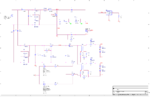jp1016
Newbie level 4
I'm new to the forum, so Hello World! Of course I have registered here because I need help with something, but the forums topics seem quite interesting, so I believe I'm about to become a follower.
Here's the deal: I have designed for my final work at college a dimmable ballast for a fluorescent lamp. The power circuit is as seen on the attached picture. It is composed basically of an LC input filter, of a full-bridge rectifier, a PFC-Boost stage integrated with a half-bridge inverter stage, and a resonant LCC filter on the output. The Lamp is represented by the equivalente steady-state resistance, derived from the voltage and power data informed by the manufacturer, that is, 101 V and 39W. The switches are turned on alternately, with a frequency that varies from 45 to 80 KHz, and a duty cycle that varies from 0,43 to 0,31, according to the desired output power (100% to about 30%). The capacitors C2 and C3 were calculated so that their voltage stabilizes at around 325 V, so the LCC tank receives a pulsed voltage of 325 V of amplitude, and filters it so that a sinusoidal voltage of 101 V (rated condition) is applied to the lamp. I have simulated the circuit thoroughly with PSpice and PSIM, and obtained the expected results. However, when I turn my prototype on on full power, it lights up the light, which keeps on for a while (30 seconds, maybe), until the MOSFET M3 burns and a short path is created from its Drain to its Source.
I have very little practical experience with electronics and circuit design, but I need to get it working within the next 15 days, otherwise I might have problems graduating =D Do any of you have a clue of what might be going on with my switch? I have replaced it and it burned again, and the last time I realized that the MOSFETs heatsink was quite hot. I've thought of buying a bigger heatsink, but I don't suppose that overheating should be a problem, given that the MOSFET (2SK1120) is rated for 150W power dissipation, and [I think that] power losses on the switch shouldn't be higher than some 5W.
Any thoughts? Thanks in advance!


Here's the deal: I have designed for my final work at college a dimmable ballast for a fluorescent lamp. The power circuit is as seen on the attached picture. It is composed basically of an LC input filter, of a full-bridge rectifier, a PFC-Boost stage integrated with a half-bridge inverter stage, and a resonant LCC filter on the output. The Lamp is represented by the equivalente steady-state resistance, derived from the voltage and power data informed by the manufacturer, that is, 101 V and 39W. The switches are turned on alternately, with a frequency that varies from 45 to 80 KHz, and a duty cycle that varies from 0,43 to 0,31, according to the desired output power (100% to about 30%). The capacitors C2 and C3 were calculated so that their voltage stabilizes at around 325 V, so the LCC tank receives a pulsed voltage of 325 V of amplitude, and filters it so that a sinusoidal voltage of 101 V (rated condition) is applied to the lamp. I have simulated the circuit thoroughly with PSpice and PSIM, and obtained the expected results. However, when I turn my prototype on on full power, it lights up the light, which keeps on for a while (30 seconds, maybe), until the MOSFET M3 burns and a short path is created from its Drain to its Source.
I have very little practical experience with electronics and circuit design, but I need to get it working within the next 15 days, otherwise I might have problems graduating =D Do any of you have a clue of what might be going on with my switch? I have replaced it and it burned again, and the last time I realized that the MOSFETs heatsink was quite hot. I've thought of buying a bigger heatsink, but I don't suppose that overheating should be a problem, given that the MOSFET (2SK1120) is rated for 150W power dissipation, and [I think that] power losses on the switch shouldn't be higher than some 5W.
Any thoughts? Thanks in advance!




